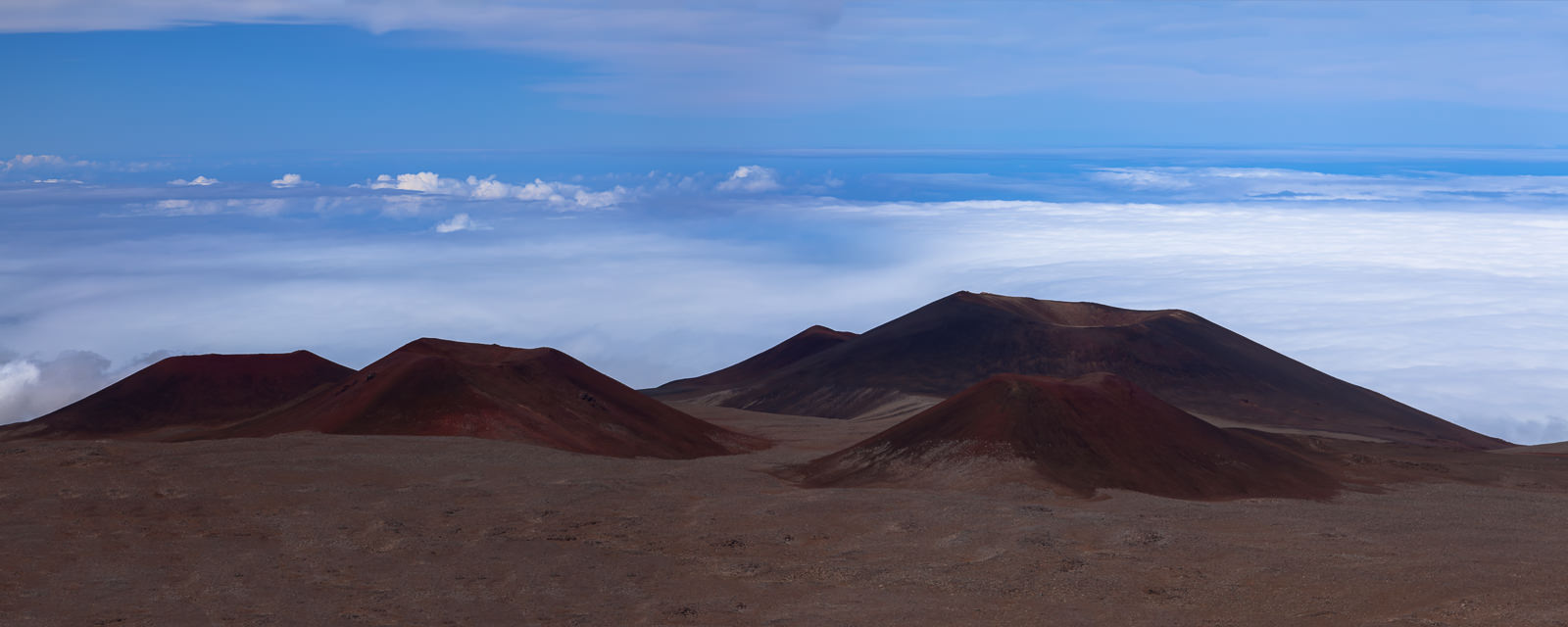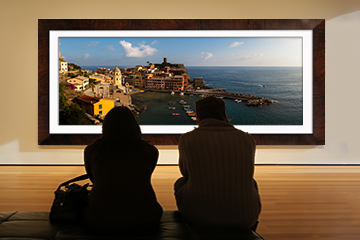
Halfway to heaven – Mauna Kea
Standing atop of the clouds, I wonder if I’m shivering from the cold or from the overwhelming view. The heavens above seem almost within reach and below the blanket of clouds and Pacific Ocean seem to go on forever. Surrounding me is a surreal landscape like that of a barren moon and the only signs of life are a dozen silver futuristic observatories. I am on the summit of Mauna Kea, the famous volcano on the Island of Hawaii.
 According to Hawaiian legend, Poli’ahu, the goddess of snow, makes her home here on the summit of Mauna Kea. Poli’ahu’s sister Pele, the goddess of volcanoes, lives on the adjacent volcano of Mauna Lea. One day Poli’ahu bested Pele in a sledding sport and in anger Pele made Mauna Kea erupt in fountains of fire intent to melt Poli’ahu’s snow and drive her from the summit. Poli’ahu countered with a mighty blizzard, covering the mountain with deep snow, driving Pele back to her home on Mauna Kea and forever quenching Mauna Loa’s fire.
According to Hawaiian legend, Poli’ahu, the goddess of snow, makes her home here on the summit of Mauna Kea. Poli’ahu’s sister Pele, the goddess of volcanoes, lives on the adjacent volcano of Mauna Lea. One day Poli’ahu bested Pele in a sledding sport and in anger Pele made Mauna Kea erupt in fountains of fire intent to melt Poli’ahu’s snow and drive her from the summit. Poli’ahu countered with a mighty blizzard, covering the mountain with deep snow, driving Pele back to her home on Mauna Kea and forever quenching Mauna Loa’s fire.
Even with its tropical location the extreme elevation makes the summit susceptible to snow and ice throughout the year. This earned Mauna Kea its name, which in Hawaiian means White Mountain. Today Mauna Kea is a dormant volcano with the last eruption occurring about 4,500 years ago. At 13,800ft it is highest peak in the state of Hawaii and if measured from the ocean floor it is 33,550ft, making Mauna Kea higher than Everest by almost a mile.
The summit of Mauna Kea is not a single peak but a large volcanic plateau typical of a shield volcano. There are many red, brown and black cinder cones. There is also an evidence of past glaciers. The landscape is completely void of flora and looks like some scene from a science fiction movie. The ground is scattered with loose volcanic rock, so it is advisable to wear proper hiking footwear (no flip-flops) and stick to the paths.
 Reaching the summit by car is a bit of an adventure. The trip from Hilo or Kona takes about 3 hours. From either side access Saddle road and follow it to the mile 28 marker. You will need to keep your eyes open as there is no turn-off sign (apparently the sign keeps getting stolen). There you will ascend about 6 miles to an elevation of 9000ft and arrive at the Onizuka Visitor Information Station. There is a lot to see and do at the centre including viewing a solar telescope, taking in a seminar and, of course, coffee and snacks. Here you also need to stay for 30 minutes to an hour to get acclimatized to the reduced oxygen levels prior to making the accent to the summit.
Reaching the summit by car is a bit of an adventure. The trip from Hilo or Kona takes about 3 hours. From either side access Saddle road and follow it to the mile 28 marker. You will need to keep your eyes open as there is no turn-off sign (apparently the sign keeps getting stolen). There you will ascend about 6 miles to an elevation of 9000ft and arrive at the Onizuka Visitor Information Station. There is a lot to see and do at the centre including viewing a solar telescope, taking in a seminar and, of course, coffee and snacks. Here you also need to stay for 30 minutes to an hour to get acclimatized to the reduced oxygen levels prior to making the accent to the summit.
Children under 16, pregnant women, and people with respiratory, heart, or severe overweight conditions are advised to travel no higher than the Visitors Information Station.
Scuba divers must wait at least 24 hours after their last dive before traveling to the summit
So far so easy… the final 5,000 feet can be more troublesome. Firstly it is dirt road with a very steep grade (20%) and a sharp drop off on one side. Furthermore auto rental agencies, with the exception of Harpers in Hilo, do not allow nor insure their vehicles for this (or even Saddle) road. No one will stop you from taking the rentals to the top but if you have an accident the car is yours.

The park vehemently recommends that only 4WDs use the final stretch of the road to the summit. On my most recent visit the rangers did not prevent me from continuing up to the summit in a Ford Mustang, but they did, repeatedly advise against it. Fortunately the road was dry, the conditions favorable and the rental performed admirably. When I returned the car the rental agency attendant did seem a bit puzzled about how the Mustang got so dirty driving from the hotel to the beach. Also be prepared on the descent back to use low gears to slow your acceleration or you will melt your brakes. If you are returning after dusk only running light are allowed as regular headlights can disturb the telescopes.

The more popular, and ultimately easier, solution to the challenging drive is to take one of the eight licensed tour operators authorized to go to the summit of Mauna Kea.
The accent is often made more intense by the thick clouds that need to be traversed prior to reaching the summit. With only a few meters of visibility the knowledge of the vast drop tends to make one a little anxious. But its all worth it as you break through the clouds and are rewarded by a breathtaking view. Separated from you by a sea of clouds is the peak of Mauna Lea and unfolding in front you is the stunning summit of the Mauna Kea.

After waiting a few minutes to get accustomed to the thinner air I took the quick hike to the peak. Although it is a short jaunt, be cautious as the path is steep and it is easy to get out of breath, especially if you have just arrived. Not only does the peak give you a stunning view but you will be able to say you hiked to the summit of the worlds highest mountain. There is also a nice short trail to Lake Waiau, a very shallow lake about a mile and a half from the summit.
The observatories are in themselves elegant and beautiful, but they are unfortunately closed to the public. The Keck observatory does have a visitors centre and a gallery opened during the day. The Ozinuka centre has telescopes and many stargazing programs that are available to the public.

There are few places in the world where one can experience so much beauty and diversity in a day. if you are lucky enough to be visiting the Big Island a trip to Mauna Kea should be in your itinerary. Aim to be there departing the summit at sunset. Just don’t forget your tripod and a warm sweater. Aloha.




























Share On